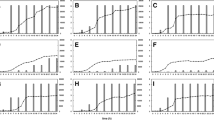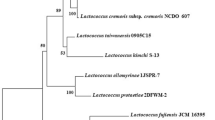Abstract
The fermentation of meat by lactic acid bacteria (LAB) is a traditional practice in many countries of Europe. LAB are already used for probiotic use and/or their bacteriocins can be used as a food preservative. 21 LABs were isolated from ham samples and identified by PCR; in particular, L. plantarum-GS16 and L. paraplantarum-GS54 were identified as the best bacteriocin-like substance (BLS) producers, active against spoilage and pathogenic bacteria, Gram negative included. In these strains, the presence of virulence factors, antibiotic and gastrointestinal resistance was investigated. The kinetics of growth and the BLS biosynthesis was also evaluated at different pH values. Finally, both bacteriocin substances were partially characterized and included in the IIa class of Klaenhammer; as a potential application, both BLSs can be successfully used as food preservatives.



Similar content being viewed by others
References
Myrto-Panagiota Zacharof (2015) In: Ravishankar Rai V (ed) Strategies for advantageous antimicrobial activity by Bacteriocins from lactic acid bacteria: higher yield, enhanced activity and successful application in foods. Advances in Food Biotechnology. Wiley, pp 511–526
Cleeveland J, Mantiville TJ, Ness IF, Chiknids ML (2001) Bacteriocins: safe antimicrobials for food preservation. Int J Food Microbiol 71:1–20
Vermeiren L, Devlieghere F, Debevere J (2004) Evaluation of meat born lactic acid bacteria as protective cultures for the biopreservation of cooked meat products. Int J Food Microbiol 1:149–164
Cano-Garrido O, Seras-Franzoso J, Garcia-Fruitós E (2015) Lactic acid bacteria: reviewing the potential of a promising delivery live vector for biomedical purposes. Microb Cell Fact 14:137
Deegan LH, Cotter PD, Hill C, Ross P (2006) Bacteriocins: biological tools for bio-preservation and shelf-life extension. Int Dairy J 16:1058–1071
Al-Madboly LA, Abdullah AK (2015) Potent antagonistic activity of Egyptian Lactobacillus plantarum against multiresistant and virulent food-associated pathogens. Front Microbiol 6:347
Russo P, Arena MP, Fiocco D, Capozzi V, Drider D, Spano G (2016) Lactobacillus plantarum with broad antifungal activity: a promising approach to increase safety and shelf-life of cereal-based products. Int J Food Microbiol. doi:10.1016/j.ijfoodmicro.2016.04.027
Saraoui T, Leroi F, Björkroth J, Pilet MF (2016) Lactococcus piscium: a psychotrophic lactic acid bacterium with bioprotective or spoilage activity in food - a review. J Appl Microbiol. doi:10.1111/jam.13179
Cotter P, Hill C, Ross RP (2006) What’s in a name? Class distinction for bacteriocins. Nat Rev Microbiol. doi:10.1038/nrmicro1273-c1
Zilelidou E, Manthou E, Skandamis P (2016) Growth differences and competition between Listeria monocytogenes strains determine their predominance on ham slices and lead to bias during selective enrichment with the ISO protocol. Int J Food Microbiol 235:60–70
Abadias M, Usall J, Anguera M, Solsona C, Viñas I (2008) Microbiological quality of fresh, minimally-processed fruit and vegetables, and sprouts from retail establishments. Int J Food Microbiol 123:121–129
Abbasiliasi S, Tan JS, Ibrahim TA, Ramanan RN, Vakhshiteh F, Mustafa S, Ling TC, Rahim RA, Ariff AB (2012) Isolation of Pediococcus acidilactici Kp10 with ability to secrete bacteriocin-like inhibitory substance from milk products for applications in food industry. BMC Microbiol 12:260
Tomé E, Gibbs PA, Teixeira PC (2008) Growth control of Listeria innocua 2030c on vacuum-packaged cold-smoked salmon by lactic acid bacteria. Int J Food Microbiol 121:285–294
Arvanitoyannis IS, Stratakos AC (2012) Application of modified atmosphere packaging and active/smart technologies to red meat and poultry: a review. Food Bioprocess Technol 5:1423–1446
Kalschne DL, Womer R, Mattana A, Pereira Sarmento CM, Colla LM, Colla E (2015) Characterization of the spoilage lactic acid bacteria in “sliced vacuum-packed cooked ham”. Braz J Microbiol 46:173–181
Bredholt S, Nesbakken T, Holck A (2001) Industrial application of an antilisterial strain of Lactobacillus sakei as a protective culture and its effect on the sensory acceptability of cooked, sliced, vacuum-packaged meats. Int J Food Microbiol 66:191–196
Metaxopoulos J, Mataragas M, Drosinos EH (2002) Microbial interaction in cooked cured meat products under vacuum or modified atmosphere at 4 °C. J Appl Microbiol 93:363–373
Alves VF, Martinez RC, Lavrador MA, De Martinis EC (2006) Antilisterial activity of lactic acid bacteria inoculated on cooked ham. Meat Sci 74:623–627
Rossi M, Altomare L, Gonzàlez Vara y Rodriguez A, Brigidi P, Matteuzzi D (2000) Nucleotide sequence, expression and transcriptional analysis of the Bifidobacterium longum MB 219 lacZ gene. Arch Microbiol 174:74–80
Kékessy DA, Piguet JD (1970) New method for detecting bacteriocin production. J App Microbiol 20:282–283
Sabia C, Manicardi G, Messi P, de Niederhäusern S, Bondi M (2002) Enterocin 416K1, an antilisterial bacteriocin produced by Enterococcus casseliflavus IM 416K1 isolated from Italian sausages. Int J Food Microbiol 75:163–170
Arslan S, Özkardes F (2007) Slime production and antibiotic susceptibility in staphylococci isolated from clinical samples. Mem Inst Oswaldo Cruz 102:29–33
CLSI (2012) Clinical and Laboratory Standards Institute. Methods for dilution antimicrobial susceptibility tests for bacteria that grow aerobically; approved standard—9th ed. CLSI document M07-A9. Clinical and Laboratory Standards Institute, Wayne
EFSA (2012) European Food Safety Authority. Guidance on the assessment of bacterial susceptibility to antimicrobials of human and veterinary importance. EFSA J 10:2740
Malinauskytė E, Ramanauskaitė J, Leskauskaitė D, Devold TG, Schüller RB, Vegarud GE (2014) Effect of human and simulated gastric juices on the digestion of whey proteins and carboxymethylcellulose-stabilised O/W emulsions. Food Chem 165:104–112
Hernandez D, Cardell E, Zarate V (2005) Antimicrobial activity of lactic acid bacteria isolated from Tenerife cheese: initial characterization of plantaricin TF711, a bacteriocin-like substance produced by Lactobacillus plantarum TF711. J App Microbiol 99:77–84
De Vuyst L, Moens F, Selak M, Rivière A, Leroy F (2014) Summer Meeting 2013: growth and physiology of bifidobacteria. J App Microbiol 116:477–491
Iseppi R, Pilati F, Marini M, Toselli M, de Niederhäusern S, Guerrieri E, Messi P, Sabia C, Manicardi G, Anacarso I, Bondi M (2008) Anti-listerial activity of a polymeric film coated with hybrid coatings doped with Enterocin 416K1 for use as bioactive food packaging. Int J Food Microbiol 123:281–287
Özogul F, Hamed I (2016) The importance of lactic acid bacteria for the prevention of bacterial growth and their biogenic amines formation: a review. Crit Rev Food Sci Nutr. doi:10.1080/10408398.2016.1277972
Kaškonienė V, Stankevičius M, Bimbiraitė-Survilienė K, Naujokaitytė G, Šernienė L, Mulkytė K, Malakauskas M, Maruška A (2017) Current state of purification, isolation and analysis of bacteriocins produced by lactic acid bacteria. Appl Microbiol Biotechnol. doi:10.1007/s00253-017-8088-9
Anacarso I, Bassoli L, Sabia C, Iseppi R, Consò C (2015) Isolation and identification of Lactic Acid Bacteria from plants and other vegetable matrices and microbial recombination with Enterococcus spp. Am Res Thought 1:1503–1515
Patel A, Shah NP, Prajapati JB (2012) Antibiotic resistance profile of lactic acid bacteria and their implications in food chain. World J Dairy Food Sci 7:202–211
Zhou JS, Pillidge CJ, Gopal PK, Gill HS (2005) Antibiotic susceptibility profiles of new probiotic Lactobacillus and Bifidobacterium strains. Int J Food Microbiol 98:211–217
Argyri AA, Nisiotou AA, Mallouchos A, Panagou EZ, Tassou CC (2014) Performance of two potential probiotic Lactobacillus strains from the olive microbiota as starters in the fermentation of heat shocked green olives. Int J Food Microbiol 17:68–76
Assefa S, Ahles K, Bigelow S, Curtis JT, Köhler GA (2015) Lactobacilli with probiotic potential in the prairie vole (Microtus ochrogaster). Gut Pathog 7:35
Asghar S, Arif M, Nawaz M, Muhammad K, Ali MA, Ahmad MD, Iqbal S, Anjum AA, Khan M, Nazir J (2016) Selection, characterisation and evaluation of potential probiotic Lactobacillus spp. isolated from poultry droppings. Benef Microbes 7:35–44
Ennahar S, Deschamps N, Richard J (2000) Natural variation in susceptibility of Listeria strains to class IIa bacteriocins. Curr Microbiol 41:1–4
Author information
Authors and Affiliations
Corresponding author
Ethics declarations
Conflict of interest
No conflict of interest has been declared.
Compliance with ethics requirements
This article does not contain any studies with human or animal subjects.
Rights and permissions
About this article
Cite this article
Anacarso, I., Gigli, L., Bondi, M. et al. Isolation of two lactobacilli, producers of two new bacteriocin-like substances (BLS) for potential food-preservative use. Eur Food Res Technol 243, 2127–2134 (2017). https://doi.org/10.1007/s00217-017-2913-3
Received:
Revised:
Accepted:
Published:
Issue Date:
DOI: https://doi.org/10.1007/s00217-017-2913-3




